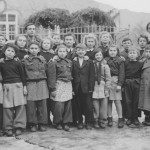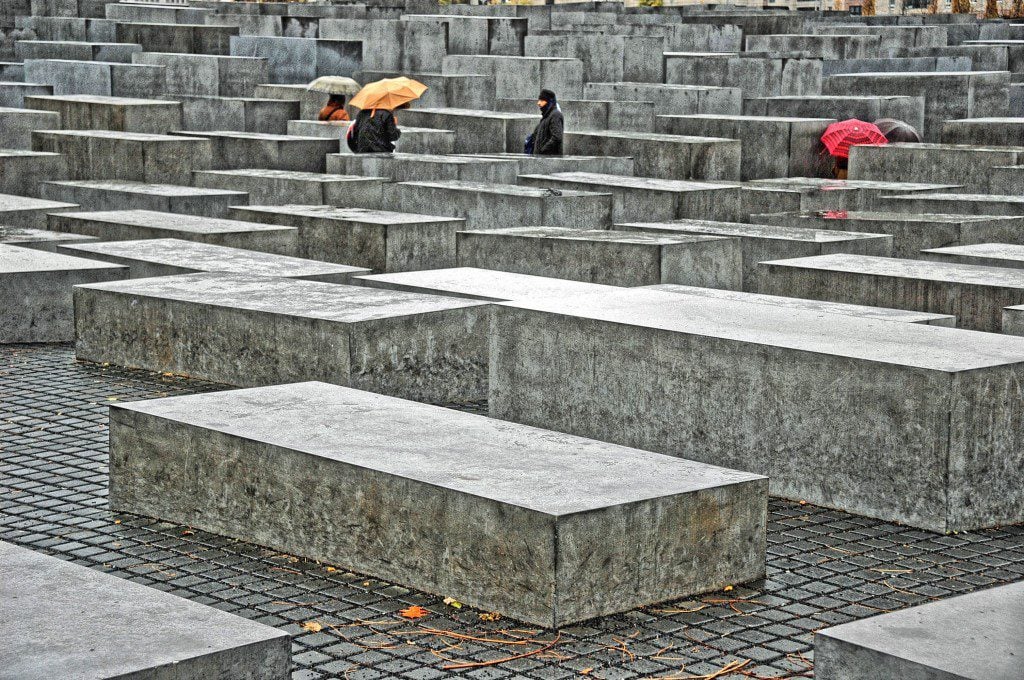![https://commons.wikimedia.org/wiki/File%3AFemale_prisoners_in_Ravensbr%C3%BCck_chalk_marks_show_selection_for_transport.jpg; See page for author [Public domain], via Wikimedia Commons](https://wp-media.patheos.com/blogs/sites/533/2017/04/Female_prisoners_in_Ravensbr%C3%BCck_chalk_marks_show_selection_for_transport.jpg)
I just finished a Holocaust memoir, The Seamstress, by Sara Tuvel Bernstein with Louise Loots Thornton and Marlene Bernstein Samuels.
That’s a mouthful: three authors. The first of these was the woman who experienced these events. She sat for extensive interviews with Thornton, who took the resulting material and shaped it into a book, then tried to get it published, but couldn’t find a publisher. Later, after Bernstein’s death, Samuels, her daughter, found the manuscript, missing various pages, in her mother’s home, and, unaware of the history, happened to meet someone who was interested in publishing it, after she did her own research to fill in what must have happened in the missing pages.
Three authors. Based on memories of events. How much was remembered? How much was recreated? The author(s) chose to fill in extensive details, with conversations throughout, rather than paraphrases and descriptions, so that it reads like a novel.
Two other memoirs I read recently were similar, but with peculiar twists.
The Girl in the Green Sweater by Krystyna Chiger consisted of her memories of her time, as a small child, in a ghetto and then in hiding in the sewers of Lvov. Her family and several others had made contact with sewer workers who, at first for a fee and afterwards, when the money ran out, at no cost, provided them with food and other provisions, during their long time underground.
What was particularly odd about this story was that only when reading about this online did I learn that there was a co-author, Daniel Paisner, and that the book was developed in the same interviewing fashion. And at the same time, Chiger mentions several times in the book that her own father kept a diary, and this seemed to have survived the war because she refers to having read it (“later I learned that. . .”). There are also some peculiar lapses in her story that presumably would have been clarified by having this text — she writes of the group losing all their possessions during a flood, but yet this memoir is not lost and she doesn’t describe any scenes of the sewer workers resupplying them with cooking equipment, etc., afterwards; she writes of the group going hungry in the final week, but then says that, upon leaving the sewer, they so struggled to find food that they went back to the sewer to retrieve their food. (To be sure, it’s possible that I didn’t read this carefully enough, and now it’s back at the library.) And there was even a movie made about their experience, In Darkness, and this was based on a book, In the Sewers of Lvov, by Robert Marshall, which was itself based on interviews and a “private diary” — was this her father’s diary? It is quite odd to me that Chiger’s book, published in 2008, seems to make no reference at all to the 1991 Marshall book; it’s hard to believe that Chiger would have been unaware of this, or that Paisner wouldn’t have done the necessary research to have uncovered it.
Here’s another one: Clara’s War, by Clara Kramer, about her family’s experiences in hiding in a crawl space under their rescuer’s house. Here too, if there was mention of the ghostwriter, Steven Glantz, in the book, I didn’t notice it when I read it. And, again, she told her memories to Glantz. And the twist: she kept a diary during her time in hiding, but we only see tiny snippets of the diary. Why was so little of the diary transcribed? She talks about using the diary, at the end of the war, as proof that the man who hid them, did just that, when he was jailed by the Soviets, so clearly at the end of the war it was in good condition, and she says that it’s now in the US Holocaust Museum.
Yes, this is how memoirs are written these days. And I would greatly prefer some sort of disclosure, some information in the book, about whether the purported author truly took pen to paper to any great degree.
But I guess it seems to me that it matters more, when it’s a Holocaust narrative. A cutesy narrative of a year as an expat somewhere? Experiences as a mom to a disabled child? A woman who lost her memory and much of her adult skills, and had to re-learn everything? Those are interesting to read, but it the author borrowed some incidents that happened to a neighbor, or adjusted the timeline for storytelling purposes, it doesn’t really matter. You’re basically just reading it for entertainment purposes.
Now, perhaps in both of these latter instances, the ghostwriter decided that it would interrupt the narrative flow to incorporate more of the primary sources. But in all three cases, would it have done any harm to have a final chapter by the “real” author, documenting to what degree the author/rememberer’s memories were backed up by historical documentation, filling in the gaps, providing context, and, yes, in the case of the two books with the diary/journal, providing greater excerpts?
For instance, in The Seamstress, she narrates a scene in which, having settled into a routine of sorts at Ravensbruck, of being a part of a work detail sorting vegetables (and managing to sneak some extra food when the guards weren’t looking), suddenly a new group of women arrived, better fed, and more aggressive, and these women took away their small group’s work detail. She reports that the women were from Auschwitz — and several other times writes of Auschwitz as having been a “better” camp. And it would have been really helpful to have some supplementary information here to make sense of this. Another example: she describes surviving for nearly two weeks without water, during the period when they are transported from one camp to another. Did her memory fail her? Is the rule of “you can survive 3 days” not really true after all? Or was there simply a lapse in editing, an omitted detail?
And it matters even more for these sorts of narratives. Of the 213 reviews for The Seamstress, one of them gives the book one star because the reviewer simply doesn’t believe that the account is true. Of the 421 reviews for Clara’s War, two of them likewise rejects the narrative as untrue. And these numbers are small but the Clara’s War review complains that prior reviews were deleted by Amazon, which suggests that there may have been others that were removed. Now, to be sure, for Holocaust deniers, their denial seems pretty non-falsifiable (that is, nothing would ever persuade them that it was real), but it still points to the importance of ensuring that memoirs do not lose sight of historical accuracy in pursuit of a compelling story.
Image: Ravensbruck survivors. https://commons.wikimedia.org/wiki/File%3AFemale_prisoners_in_Ravensbr%C3%BCck_chalk_marks_show_selection_for_transport.jpg; See page for author [Public domain], via Wikimedia Commons. Note that despite the URL, the X’s were how they were marked as prisoners, and had nothing to do with a transport.















